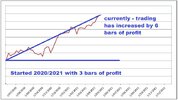- Joined
- 28 December 2013
- Posts
- 6,401
- Reactions
- 24,350
Trend Indicators
A few simple trend indicators are all you need to see when to enter a position. Entries during trends require almost no brain cells. Once we have our entry, the problem becomes one of exit strategy & money management. A simple 10-period moving average is all you need on a chart to see a trend.
10-period SMA
If the closing price is above the 10-period simple moving average it’s in an up-trend. When the close is below the 10-period moving average it’s in a down-trend. Indicators don't provide buy or sell signals - their primary function is to determine whether the timing for the entry or exit is optimal & they are essentially the main drivers in coordinating the trading strategy.
Some indicators
(ATR) is a volatility indicator, combined with a momentum indicator (ROC) tells a powerful story. A Commodity Channel Index (CCI) is a momentum-based oscillator used to determine overbought or oversold conditions but this indicator is best used in conjunction with additional indicators. The Rate-of-Change (ROC) indicator is a simple Momentum indicator (my favourite indicator) & I use the ROC indicator in every strategy that I code to confirm the increasing momentum of a trend. The exponential moving average (EMA) is just one variety of moving averages to choose from. The (EMA) used by itself has no special powers but use it in combination with others turns the (EMA) into a superhero.
More to follow.
Skate.
A few simple trend indicators are all you need to see when to enter a position. Entries during trends require almost no brain cells. Once we have our entry, the problem becomes one of exit strategy & money management. A simple 10-period moving average is all you need on a chart to see a trend.
10-period SMA
If the closing price is above the 10-period simple moving average it’s in an up-trend. When the close is below the 10-period moving average it’s in a down-trend. Indicators don't provide buy or sell signals - their primary function is to determine whether the timing for the entry or exit is optimal & they are essentially the main drivers in coordinating the trading strategy.
Some indicators
(ATR) is a volatility indicator, combined with a momentum indicator (ROC) tells a powerful story. A Commodity Channel Index (CCI) is a momentum-based oscillator used to determine overbought or oversold conditions but this indicator is best used in conjunction with additional indicators. The Rate-of-Change (ROC) indicator is a simple Momentum indicator (my favourite indicator) & I use the ROC indicator in every strategy that I code to confirm the increasing momentum of a trend. The exponential moving average (EMA) is just one variety of moving averages to choose from. The (EMA) used by itself has no special powers but use it in combination with others turns the (EMA) into a superhero.
More to follow.
Skate.





